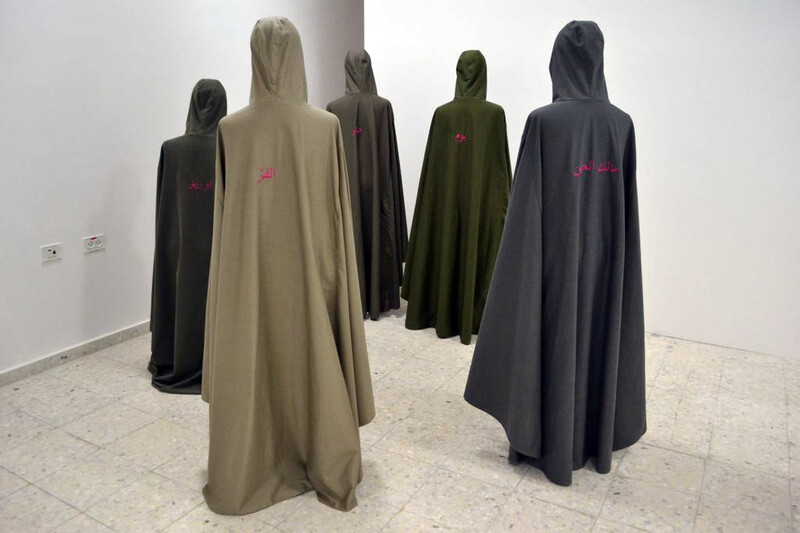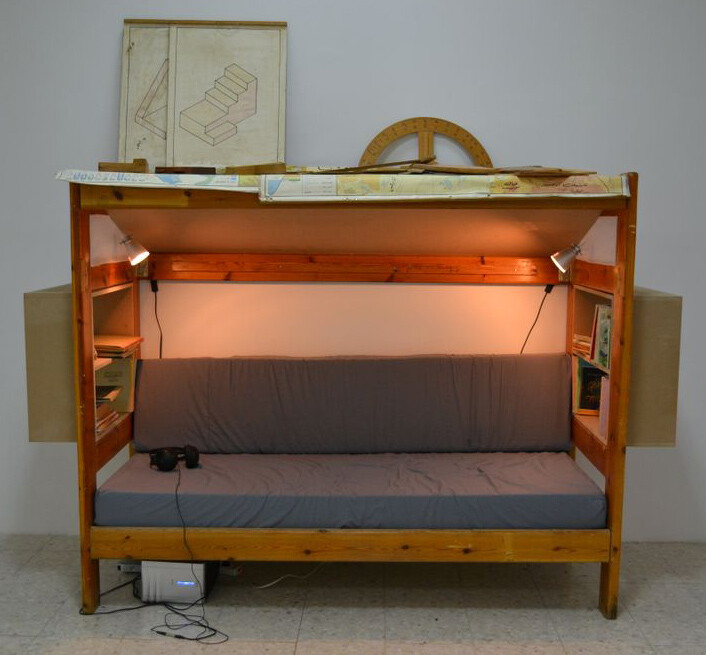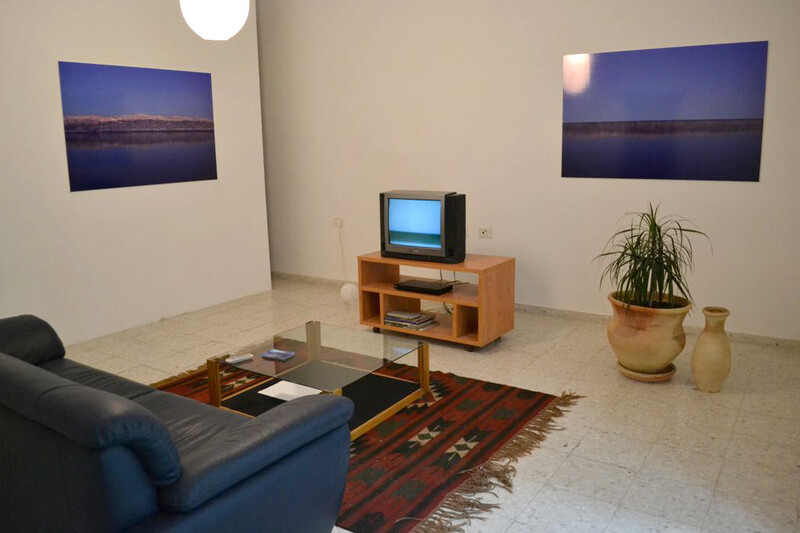The Electronic Intifada Birzeit 18 March 2013

“Journey to the Moon” by Sarah Beddington (2013).
The exhibition Jericho — Beyond the Celestial and the Terrestrial appears small, compiled of one major work or installation by each of the five artists involved. But the show — now running at the Birzeit University Museum in the occupied West Bank — is built upon long processes of research and creativity, resulting in several extensive and atypical considerations of the city of Jericho.
Part of the Cities Exhibition, founded by Ramallah-based artist Vera Tamari, it follows a series of other shows based on studies of West Bank cities. The past editions have focused on Jerusalem, Ramallah and Nablus.
Curator Yazid Anani proposed that each artist develop his or her work around a different conceptual theme: contemporaneity, land, humanity, wildlife and cosmos.
Oasis

“Untitled” by Iyad Issa (2013).
Palestinian artist Iyad Issa, exploring the idea of contemporaneity, organized a fleet of brightly-colored four-wheeled vehicles to take participants off-roading in Jericho. The cars visited desert terrain, refugee camps, housing developments built of steel, and the archaeological site of Hisham’s Palace, among other locations in the city.
In the exhibition, a bright red jeep faces a wall. Visitors are allowed to enter the jeep and watch video footage of the excursions projected on the wall in front of it. The simulated tours were meant to explore the idea of Jericho as an oasis, surrounded by the existing conflict, but the sites that the jeeps visited allowed for speculation on some of the contradictions in this idea, and in the development of the city.
Jordan-based artist Samah Hijawi took on the concept of land by investigating the geological possibility of earthquakes along the Great Rift Valley. The artist pondered the consequences of all of historic Palestine disappearing in the aftermath of an earthquake. From this idea, Hijawi brought her project to Jericho’s main public square, inviting citizens to come and discuss the idea of a complete disappearance of the land of Palestine, and re-imagine their personal political solutions based on that.
The artist took her public debate and placed it back in the context of the home, creating a livingroom with couches, coffee tables, a rug and a television playing footage of the political conversations.
Silent walk

From Susanne Bosch’s “Change Makers” installation (2012).
Examining the concept of humanity in Jericho, Susanne Bosch — a German artist dividing her time between Belfast and Berlin — took a three-hour silent walk with 75 participants that brought them to a socialist agricultural project from the 1940s funded by the Arab Development Society. The project had a goal of establishing a self-sufficient Palestinian community that could survive without aid, debts and credit.
In the gallery, the artist explores the founding ideas behind the Arab Development Society. Her three-part installation features pages from a history book of the ADS, projections of video footage of the project, and a seating area with books and listening materials.
While the ADS initiative, if largely defunct now, was an interesting one, the piece seems far removed from the original idea of a silent walk. Perhaps more interesting are the notes written by some of the participants in the walk, published on the artist’s website (www.susannebosch.de). From comments about the beautiful silence of the procession, to statements such as “Why was I created a Palestinian?”, the notes seem to indicate more about the humanity of Jericho than the investigation of the Arab Development Society.
British artist Sarah Beddington devised another public procession through Jericho, this one based on bird migration. The artist and volunteers wore embroidered cloaks as they walked up Wadi al-Auja, close to Jericho, pausing to read excerpts from a 12th-century Sufi poem that describes a spiritual migration of birds in search of a leader.
Yazid Anani, the curator, said: “The work is based on reinterpreting the diminishing relationship between Palestinians and their landscape; moreover, it is also a critique of the concept of ‘central leadership’ as opposed to ‘collective leadership.’” In the gallery, the artist displays the cloaks worn by the participants on mannequins, facing towards a wall and showing their embroidered Arabic names of different birds.
Confrontation

Samah Hijawi’s installation “It collapses in the living room” (2013).
Palestinian artist Shuruq Harb’s walk, as described by Anani, “was a confrontation with the schizophrenic Palestinian identity in terms of our relation to Jewish archaeological sites.” The work asked the question of whether Palestinians could reclaim their Palestinian Jewish archaeological sites as part of the history of Palestinian Jews in Palestine.
In a hallway of the gallery, the artist created a sign pointing to the fictitious “Center for Jewish Studies,” which does not exist at Birzeit University. Projected in the hallway is footage of “Jewish Jericho,” a propaganda YouTube video meant to promote the Jewish history, culture and traditions of Jericho. Visitors to the gallery find themselves somewhat stuck in between a Zionist narrative of Jericho and a non-existent place for studies of the subject, leaving a lack of answers but new avenues for discussing the issue. Interestingly, a group of young men and women from Jericho decided to conduct several similar tours in the footsteps of Harb’s walk.
Jericho sets out to draw upon varied relationships within the city between space, time, history and people. It aims to transcend the stereotypical and draw new conclusions about the city’s political situation.
While sometimes journeying into dangerously abstract realms of exploration, the processes returned to the physical reality and possibilities of the city of Jericho, uniting the material and the immaterial.
Jericho — Beyond the Celestial and the Territorial is on display in Birzeit University Museum until 25 April.
All photographs by Daryl Meador.
Daryl Meador is a recent graduate of the School of the Art Institute of Chicago who is currently living and volunteering in Nablus.






Comments
WIDE SEAS ----MY SMALL BOAT
Permalink Peter Loeb replied on
In 1965 I was in Mississippi working for and with African Americans. ( Yes, I really
AM that ancient !)
A small girl put a prayer on a poster which reads in part:
THE SEA IS SO WIDE
AND MY BOAT
IS SO SMALL
Those words still hang in a frame above my bed.
I am not in Palestine but in the United States. In Palestine---let's NOT call it
"Israel" --- Zionism was developed in the last part of the 19th century from
a movement called "Social Darwinism" where one group self-defined itself
as "civilized' and therefore superior. Another group was defined as "uncivilized" such as Native Americans in North America, Palestinians, African Americans.
Begin by forgetting about "Israel" which is the result of such beliefs or "New Israel"
which conquered Native Americans or Germannic culture in which Teodor
Herzl lived. We are Palestine and I am only a small boat accross a wide sea.
I am not too old to learn. This art is one way of teaching the world. There are many ways of teaching...